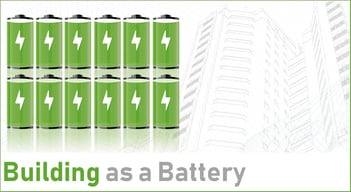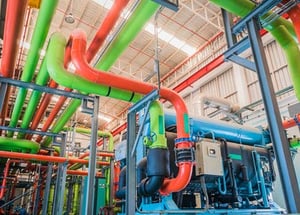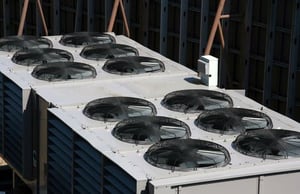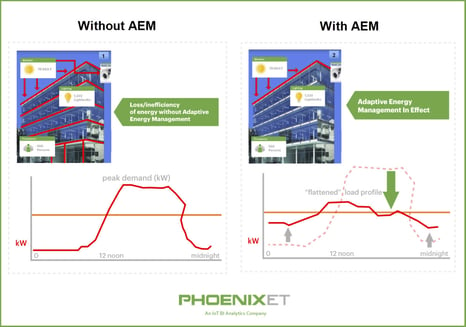Share this
What Facility Managers Need to Know About Load Shifting - Part 2
by Phoenix Energy Technologies on Oct 28, 2019
Buildings heat up excessively when their occupied and unoccupied summer setpoints are set too high, beyond 70-74 degrees Fahrenheit occupied, 74-78 (max) unoccupied. Usually setpoints are set too high because the building manager is trying to save energy. Typically, they set the thermostat to a higher temperature for cooling, such that the system is generally off during these periods.
In Part 1 of this blog series, we explained why this isn't a good idea.
To truly save energy, building managers should understand Adaptive Energy Management (AEM) and how they can use their buildings' thermal mass as a "battery" to store cold energy during the night. This concept is referred to as BaaB — "Building as a Battery."
 BaaB works best for buildings made from concrete and metal because these materials are great for absorbing and storing heat (or cooling) energy. If your building or facility is made from wood, BaaB won't work as well because wood is an insulator and terrible at absorbing heat energy.
BaaB works best for buildings made from concrete and metal because these materials are great for absorbing and storing heat (or cooling) energy. If your building or facility is made from wood, BaaB won't work as well because wood is an insulator and terrible at absorbing heat energy.
By using AEM, not only do building managers save on energy costs, but they also reduce the wear and tear on their HVAC equipment. This is a result of efficiently changing the working duty cycle of the RTUs (rooftop air conditioning units).
How Does AEM Reduce Wear and Tear on Your Cooling System?
 When facility managers allow a building to overheat during the night when the building is unoccupied, cooling systems struggle the next day.
When facility managers allow a building to overheat during the night when the building is unoccupied, cooling systems struggle the next day.
The building cannot compensate for the build-up of heat as it is now in the position of trying to cool hot air coming in from the surroundings AND contend with the stored heat from the night before.
As such, the system struggles to do three things simultaneously:
- Cool the air coming from the RTU to achieve the occupied setpoint
- Reduce the heat stored in the building's thermal mass
- Combat the new heat that is generated when the sun's radiant energy hits the building.
Adaptive Energy Management - How to Use Your Buildings as a Battery
Increased Efficiency
 When the HVAC system has to run as described above, it places great stress on the unit.
When the HVAC system has to run as described above, it places great stress on the unit.
It causes the system to:
- Increase energy usage during the day, when costs and demand have peaked
- Increase wear and tear on the actual unit
- Increase the frequency of maintenance
- Increase instances of unexpected downtime and repairs
None of the above saves energy. None of the above saves money. All of this is the exact opposite of what the building manager was trying to achieve.

By applying the principles of load shifting and "Building as a Battery," facility managers can help their buildings assume a cooler profile at night. This reduced energy costs while gaining some benefit from "free" outside air cooling. Controlling load shifting allows managers to invest the stored energy into the day-time operations. This results in enhanced comfort and stability for building occupants, less load on the cooling systems, and improved energy savings.
How Does AEM Increase Your Building's Energy-efficiency?
Implementing AEM requires building managers to measure the thermal mass of their buildings continually.
This allows them to:
- Determine the impact of the heat from the sun's radiant energy on the outside of the building
- Determine the amount of air flowing into the RTU
- Assess the temperature needs of the building during unoccupied and occupied periods
- Intelligently set, monitor, and adjust the setpoints as all these needs and factors fluctuate
Saving money and energy through AEM would be a somewhat impossible task without a way to effectively measure the above.
The best way to measure is by using a smart building system. The right system allows managers to:
- Pairs actionable data with real-time predictive data
- Monitoring assets and building analytics
- Reduce capital equipment and energy costs
Introducing EnterpriseDX® Energy Management Software
Through real-time measurement of contextual data (such as weather, occupancy, and schedules) as well as verification of energy use and related costs, PhoenixET's EnterpriseDX® Smart Building Platform controls, monitors and manages millions of data points from HVAC systems and IoT devices in your building to help maximize comfort and savings.
One of the most valuable IoT energy management platforms, EDX improves occupants' comfort, reduces energy consumption, and optimizes building performance by automatically sending remote signals to various parts of your building to optimize temperature within your defined parameters.
EDX helps achieve AEM by applying the principle of load shifting and measuring your building's thermal mass to intelligently adjust your setpoints to achieve maximum comfort and energy savings.
Related posts
What Facility Managers Need to Know About Load Shifting - Part 1
Adaptive Energy Management Guide
Are You Managing Your Energy Spend?
4 Common Myths of Energy Conservation in Building Management
Precision Building Management: Understanding Closed Loop Control
Share this
- Facilities Management (91)
- Energy Management (69)
- Company News (49)
- Smart Buildings (37)
- Retail (36)
- Building Management (24)
- Building Automation Systems (21)
- Sustainability (20)
- Energy Demand Management (19)
- EEI (15)
- Adaptive Energy Management (14)
- Grocery (14)
- demand response (14)
- Artificial Intelligence (12)
- Data Integration and Visibility (10)
- HVAC IQ (9)
- COVID-19 (8)
- Customer Spotlight (8)
- Carbon Management (7)
- Setpoints and Temperatures (7)
- Equipment Maintenance (6)
- Operational Efficiency (6)
- Refrigeration Optimization (6)
- Ask Ron (5)
- Asset Manager (5)
- Finance and Procurement (5)
- IoT and Digital Transformation (5)
- Awards (4)
- Comfort (4)
- Energy & Store Development (4)
- Safety and Compliance (4)
- Demand Charge Management (3)
- Energy Management System (3)
- Lifecycle Asset Management (3)
- Premium Services (3)
- Refrigeration IQ (3)
- Automated Demand Response (2)
- ConnexFM (2)
- Customer Service (2)
- HVAC Vendor Management (2)
- Load Shedding (2)
- Technician View (2)
- AIM Act (1)
- ALD (1)
- Analytics (1)
- Data (1)
- Data Integration and Visualization (1)
- EMS (1)
- Knowledge Center (1)
- OSHA (1)
- asset management (1)
- December 2025 (1)
- November 2025 (1)
- October 2025 (2)
- September 2025 (1)
- August 2025 (3)
- July 2025 (1)
- June 2025 (1)
- May 2025 (2)
- March 2025 (2)
- February 2025 (1)
- January 2025 (2)
- December 2024 (2)
- October 2024 (1)
- September 2024 (1)
- August 2024 (2)
- June 2024 (2)
- April 2024 (2)
- March 2024 (2)
- January 2024 (1)
- December 2023 (1)
- October 2023 (2)
- September 2023 (2)
- August 2023 (2)
- July 2023 (1)
- May 2023 (2)
- April 2023 (2)
- March 2023 (3)
- February 2023 (1)
- January 2023 (1)
- December 2022 (1)
- November 2022 (2)
- October 2022 (2)
- September 2022 (1)
- May 2022 (2)
- April 2022 (1)
- March 2022 (3)
- February 2022 (2)
- January 2022 (4)
- December 2021 (2)
- November 2021 (3)
- October 2021 (1)
- September 2021 (3)
- August 2021 (4)
- July 2021 (1)
- June 2021 (2)
- May 2021 (1)
- January 2021 (2)
- December 2020 (2)
- November 2020 (2)
- October 2020 (3)
- September 2020 (4)
- August 2020 (3)
- July 2020 (2)
- June 2020 (3)
- May 2020 (3)
- April 2020 (5)
- March 2020 (5)
- February 2020 (4)
- January 2020 (4)
- December 2019 (4)
- November 2019 (3)
- October 2019 (4)
- September 2019 (5)
- August 2019 (4)
- July 2019 (4)
- May 2019 (2)
- April 2019 (3)
- February 2019 (1)
- December 2018 (1)
- November 2018 (1)
- October 2018 (3)
- September 2018 (3)
- August 2018 (3)
- July 2018 (3)
- June 2018 (3)
- May 2018 (1)
- June 2015 (1)
- March 2013 (1)
- January 2013 (1)
- December 2011 (1)
- October 2011 (1)
- September 2011 (1)



